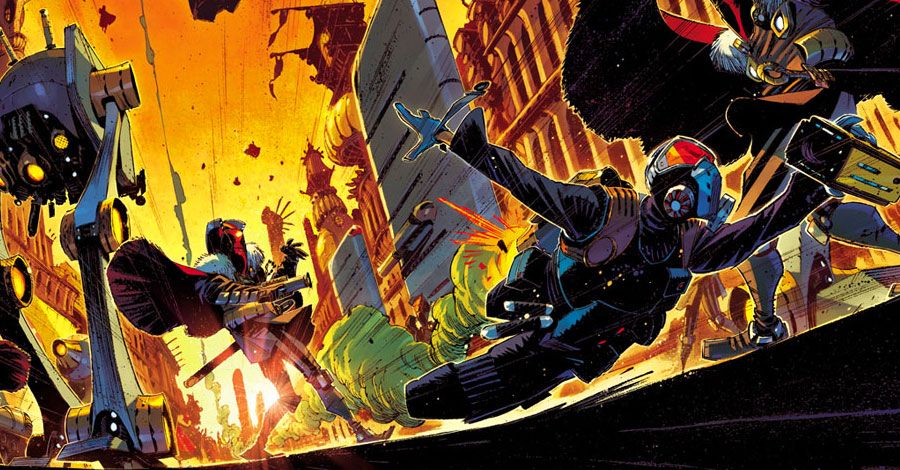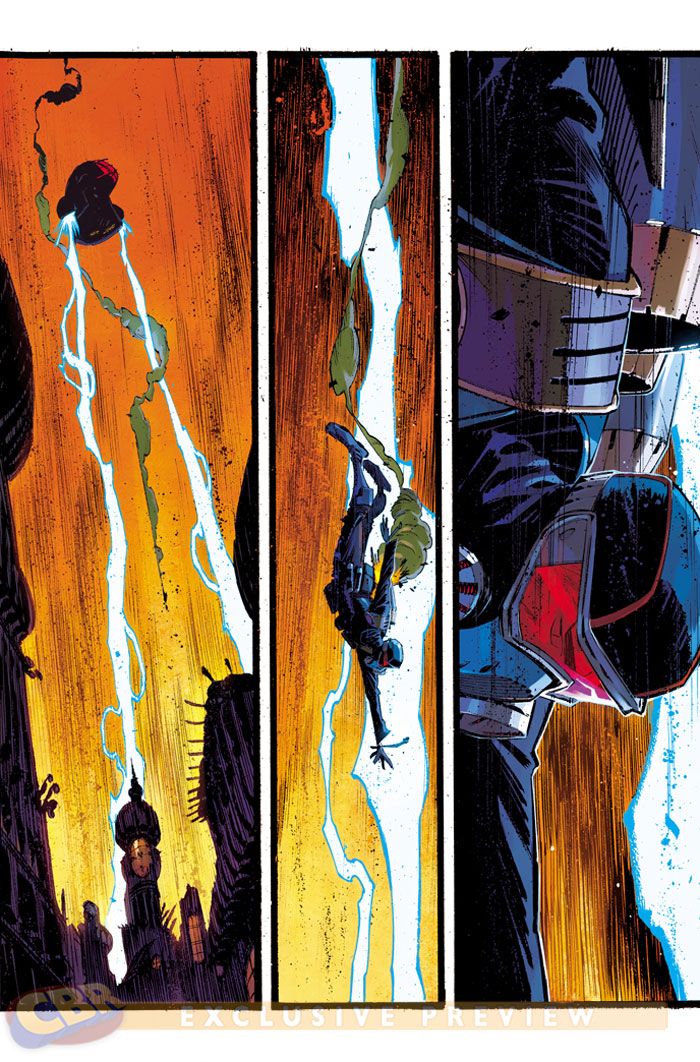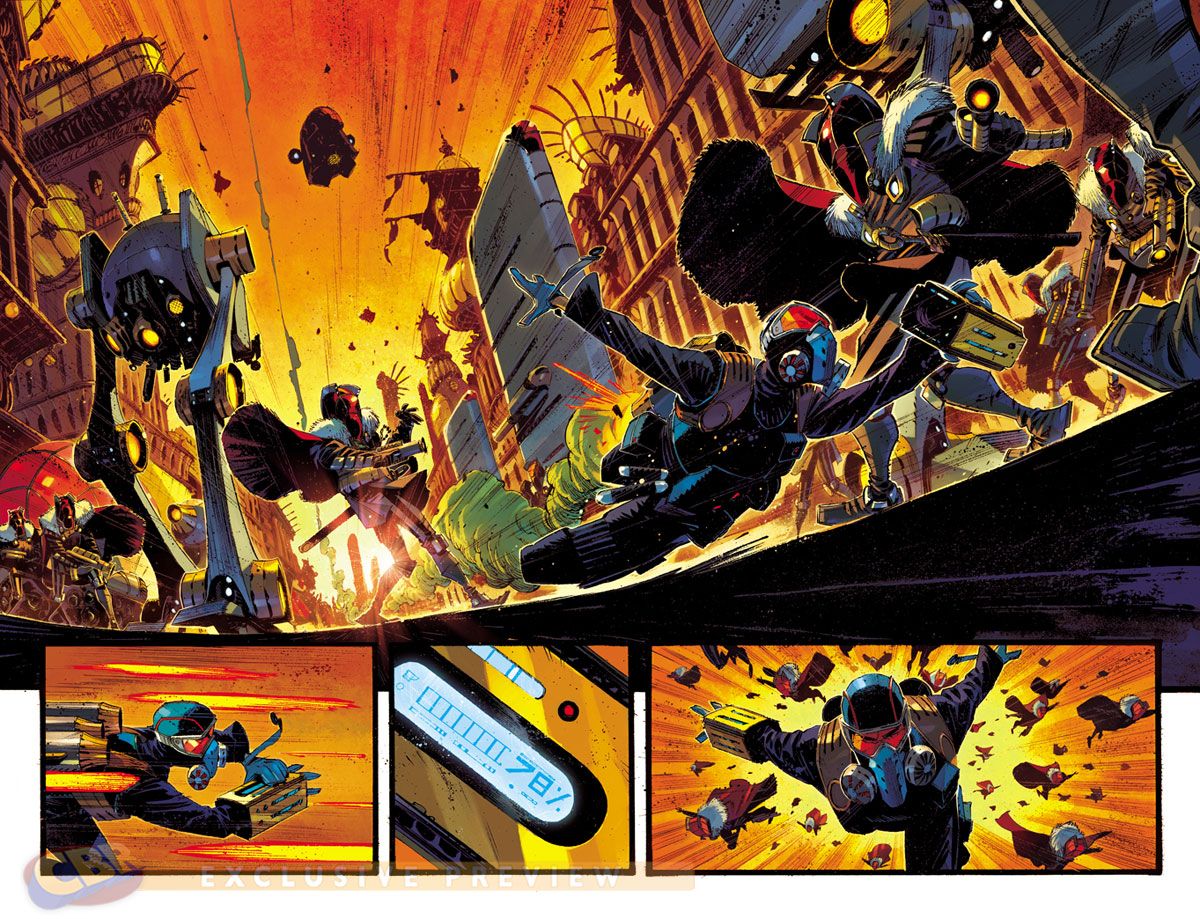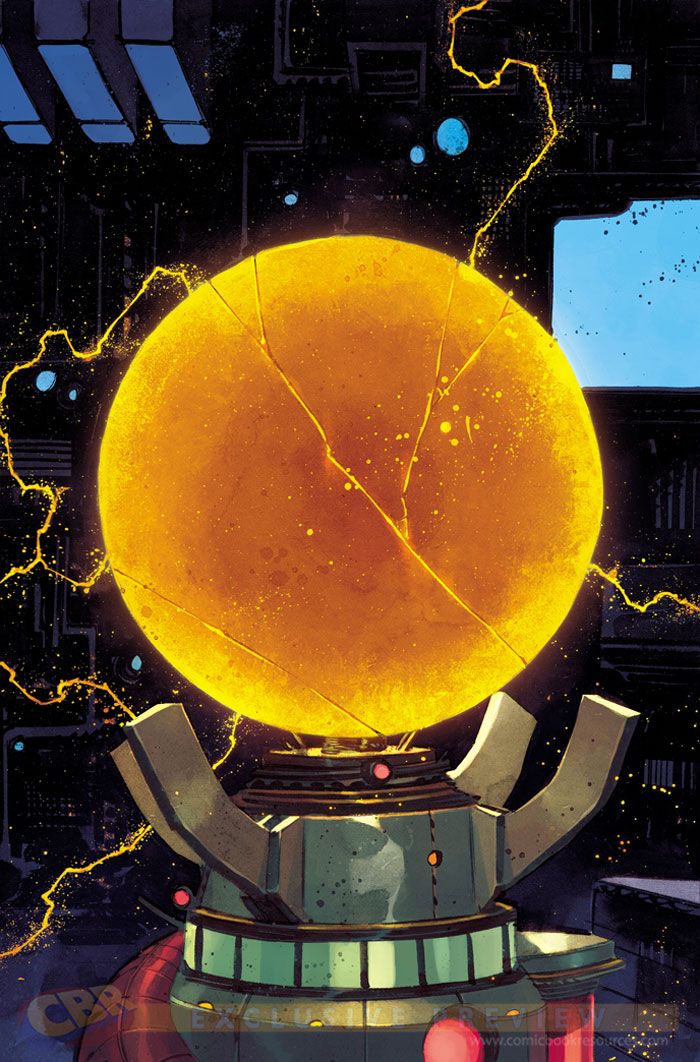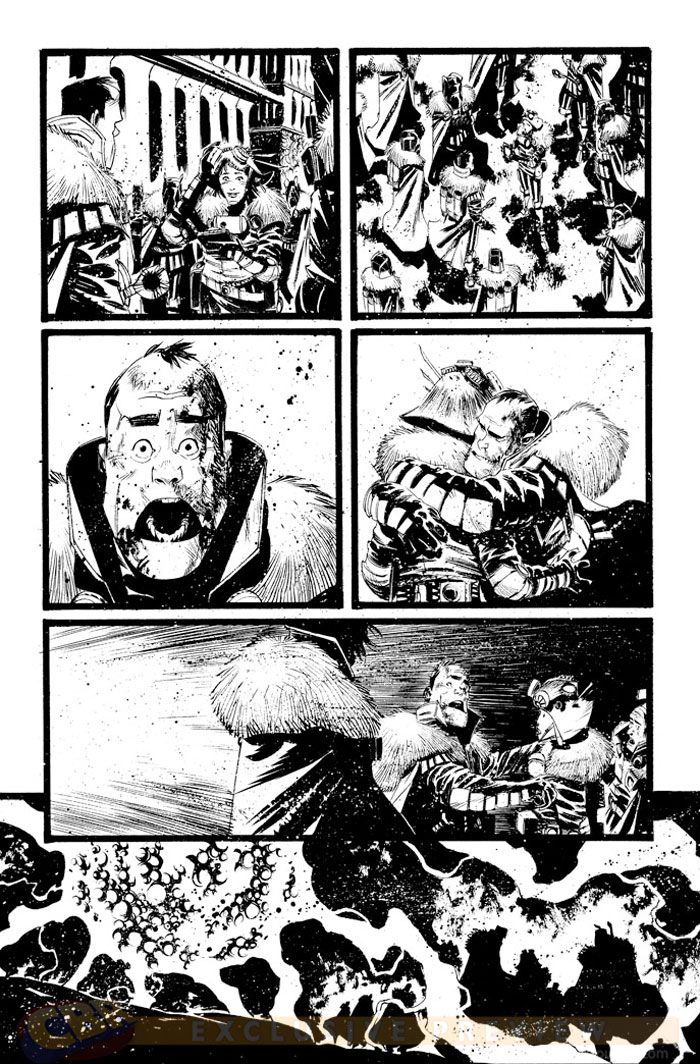The choices we make and how we treat others can have a ripple effect that impacts our world, so even in the smallest communities, how you treat your environment and your neighbors is very important. But what if the choices you make impact not just your world, but thousands of others? What would you do if you discovered the consequences of your actions rippled into a multitude of other realities?
These are the questions that the cast of Rick Remender and Matteo Scalera's "Black Science" are wrestling with. The creator-owned Image Comics series follows the exploits of the Anarchist League of Scientists, who have built a device called the Pillar that allows them to traverse the myriad alternate realities that make up the "Eververse." Recent issues have seen Grant McKay and his comrades confronting some difficult truths and wrestling personal demons as they try to come to grips with and survive what they encounter every time the Pillar jumps them to a different dimension.
RELATED: Remender, Craig Build a Curriculum of Intrigue, Pain & Pathos in "Deadly Class"
CBR News spoke with Remender about the current arc dimensionaut Grant McKay is experiencing, the joy he finds in creating alternate dimension concepts for Scalera to bring to life, the challenge of maintaining the series' velocity, and how the action and direction of "Black Science" is about to change in a big way.
CBR News: Each "Black Science" cast member has a different arc, but it feels like what has been driving Grant McKay's arc since before the book began is a sense of fear -- fear of being a bad parent and dooming his kids to a bleak future.
Rick Remender: Absolutely. Look, as a father of a four-year-old and a five-year-old, I'm terrified of being Grant. Last year, my workload was so out of control and overwrought that I was working almost every hour I could be awake, so I could only find a couple hours a day to be with the kids. And even before that, it's such a paralyzing fear that you want to be there for your kids and enrich them and teach them. You want to be a great parent, but you also have to pay the bills. You also have to go to the gym and take care of the yard and maybe squeeze in a life of your own on the side.
That's life, and there's not enough hours in the day. So I think that fear is such an interesting one to examine. I've had a year or two that have been pretty gnarly work-wise over the past five or six years, so I can identify with becoming a workaholic and losing yourself in that process. Grant has done that non-stop for ten years though, and has missed his life entirely to create the Pillar. It's taking a bit of the fear I've experienced and really magnifying it and digging into what I'm afraid of by having Grant make those mistakes and then examining the consequences. Grant is like a cautionary tale for anybody who is raising kids and getting lost in work, or themselves, or chasing money, or anything else.
We've seen how Grant's actions have affected his family, but we've also seen how they've affected other realities as well. A major theme of "Black Science" seems to be that, even in a world of infinite possibilities, actions and how you treat people matter.
For sure. It's a lot of the same people repeating a lot of the same patterns and a lot of the same patterns displaying themselves through other dimensions. We'll get to the why and what for of that stuff later on, and we might see that we're not all such special snow flakes and maybe there's a lot more to the "nature/nurture" in terms of our wiring.
That's an interesting aspect to play with, and I have some ideas that I think are fun and exciting that I don't want to spoil yet. It plays on a lot of those themes, and that's sort of the heart that makes the book grow beyond its initial premise of people jumping through dimensions and fighting stuff.
Beyond something like a dysfunctional "Lost in Space"-style family meets "Sliders."
[Laughs] Yeah, everything has been done at this point. You have to differentiate it up as much as you can. We've seen wayward people stumbling through dimensions, and it's a concept that I had almost written off until I got into the cast, the heart of the characters, and the idea of a punker, an anarchist who never gave up the fight, never saw it as adolescent or something to outgrow. Someone who's an anti-authoritarian person who thumbs his nose at all rules and regulations and does things his way, even though it has a ton of consequences.
That's something I'm sort of drawn to, myself, and I thought we'd look at the consequences of what happens from that beautiful idea of, "I answer to no authority but myself. I'm a stout hearted and right minded person and I will make the best decisions without rules and regulations from a bureaucracy!" [Laughs] There's a lot of good to be had from that, but I think it's also interesting to examine the bad as well.
We get a little bit of both, and at the heart of it was a good motivation. It's the same when I've worked too hard and just locked myself in a cave for a year and typed. My motivation is, I'm fearful of the future. I'm fearful of a world with no honeybees, no plants, pine beetles eating up entire forests, and global climate change. I'm terrified of the future for my kids, and I want to try and make sure they got some college money and something set aside. Fear as fuel to kill oneself.
The initial instinct for our cast to build the Pillar was to go to any dimension and collect any resource. That's a pretty good one, but it has some unintended consequences, and Chaos Theory kicks in. That's when the dinosaurs come to eat you and things don't go as you planned. [Laughs]
Let's talk about some of the various dimensions that we've visited so far and what inspired them. My favorite was the pulp Egypt dimension.
Yeah, I want to go back to that. Matteo's designs for that pulp Egypt were so cool.
A lot of it comes from an aesthetic. Matteo is such a versatile and amazing artist that I try to challenge him and cook up things that will be visually very unique. We originally had three to four issues with the pulp Egypt, and the first 11 issues of "Black Science" were originally about 20. I'm constantly trying to find a way to keep the pace moving just fast enough where you're getting the information you need, but if you're not paying attention something could slip by.
I like velocity in my entertainment. I don't want my time wasted with sort of self-indulgent, long-winded things, so I trimmed my outline of those issues down and just kept the cream. There was originally a six-issue story with the millipede death cult, and I realized I don't need six issues for that. I can get that done in three issues, and I can take the Egypt thing and pepper that in as a B-story, so you're thrown off balance in that second trade. It's constantly shifting to these new worlds and new places. That's sort of the promise of the book, and I think that's the fun of it.
The only arc that I've left intact from the outline was the third arc, where we stay in one world and it's a very structured character story. I've seen most of Matteo's art for "Black Science" #16, and it's among the best comics I've been associated with. It's something special. It's been 15 issues of build, so when we finally get to the 16th issue, it's where it all comes together. It's pretty thrilling to spend that many years on something and finally arrive at the point where you're like, "HA-HA!" [Laughs]
As for the other worlds, a lot of it stems from something visual and silly ideas. Or things like, "What if a version of Grant who was a praying mantis had a Pillar and he came to an Earth and stumbled upon some Native Americans who were pretty pissed off from fighting the white man who had been taking their land and giving them smallpox blankets? They killed the praying mantis and then the Pillar offered to help them. They accepted that offer, and used the Pillar to go to other dimensions to grab tech. They then used that tech to do what the white man was doing to them, and took over the rest of the world."
[Laughs] That immediately is a visual idea. It's a bunch of Native Americans in cyber armor on the warpath getting revenge and turning the tide on a civilization that had encroached upon theirs.
Then that next world was like, "What if Earth was an intergalactic truck stop?" [Laughs] And that's all it was! There were Motel 6s and giant vending machines. That's what that world was. That was the joy that initially drew me to the concept; being able to cook that kind of stuff up for Matteo to draw.
One of the things I loved about the pulp Egypt setting was how connected and thematic it felt to Grant at the time. He was deciding to be a hero, and in that world Matteo gave him that great heroic pose with the machine gun.
Yeah -- it felt like this great "Maltese Falcon," "Indiana Jones," pulp noir style setting with all of those wonderful trappings. That was the beginning of Grant's "turn around and face it." And again, instead of spending five issues in that world, we spent all of 18 pages in that world. I just grabbed the core points of the story. I left those intact and cut everything else. We filled in the gaps through a kind of ethereal, non-specific captioning that will make more sense in the story as we progress and see things.
Hopefully it keeps readers off balance. I like that effect. I write these big outlines, and if we were to go with the original shape of them, to get where we are in issue #16 would have happened in issue #25. I'm trying to take giant hunks of story and gut them out of it so we get these very interesting quick blips. Hopefully it's something that people keep enjoying, because I love writing it that way.
The last thing you ever want is to waste your audience's time or make them bored. I always strive to lean into the pulp of it all, lean into the old Lester Dent stuff.
I'm a fan of Dent's most famous creation, Doc Savage.
Yeah, he has a famous structure he used on that stuff that I sometimes turn to. It's a wonderful formula, and always interesting. It's great for pulp and big fantastic settings with characters whose deficits cost them, beautiful black widows, and damsels and all that stuff. I think the challenge is to merge that with a story that has a universal poignancy and things that other people can identify with and it says something to them about their lives. That's the magical mix
Your cast has been wrestling with their personal demons; in some worlds, we see versions of them that are heroic, and in other realities, we meet counterparts that are entirely selfish. There is one character, however, who seems consistently selfish and evil in most of the worlds we've met him in: the enigmatic Mr. Block.
We've kept him boiling in the background. You see little glimpses of things like the Shaman's brother is Mr. Block in his world. And in our world, Mr. Block is this shadowy figure who is talking to Kadir.
The first real glimpse you get of him is in the second arc, where he's not only the head of the millipede death cult, he's also the guy who wants to be the Pharaoh Absolute and take over the world. He's sort of the big boss character, and I like taking my time with those characters and to keep people guessing. We know very well in the outline that my editor Sebastian Girner, Matteo and I have been working on what Mr. Block's role is. Around issue #25, I believe, we're going to get a big surprise from Mr. Block and what he's up to.
The surprises keep coming. We've got this thing outlined up to issue #50. There's just so much great stuff that's all been seeded. The hard work has been done. The characters are developed and the world has been built. Now, it's just unravelling all of the various mysteries we've set up, and the Mr. Block one is a big on,e for sure.
The end of issue #14 suggests we're going to be staying in the current, plague-ravaged world while Grant and his associates search for a cure, but I hear we'll be getting more insight to the character of Rebecca.
A lot of what's happened with Rebecca has been B-story. It's another story we have percolating. We got to see that when she was younger she was out running through the woods and her brother fell in a well and died. That's about to play a pretty big role in the story and her motivations for doing all of what she's done.
Rebecca is a character I wanted to develop slowly because of the way this arc plays out, but we've set up a lot of little things with Rebecca throughout the first, second and even third story that could maybe even get lost in the shuffle, which is good. It's almost been like C- or D-story stuff. I've made sure to pepper in all the seeds, though, and I'm pouring water on them so when things start to grow out of them, it's natural and been there the whole time.
The Rebecca story really, really picks up in issues #15 and #16.
I understand the book is about to experience a shift or revelation that might impact the larger narrative in a rather dramatic fashion.
Yeah. In order to make anything have resonance and feel earned or have impact with the readers, it really does take a lot of building when you get to that point to hit them with it. We're finally there. [Laughs] We're finally at the point where all this fun stuff that has so excited us is finally going to gel into a new direction for things that I think is going to be unexpected -- but again, it's been seeded throughout and has been there the whole time.
The point of all of the relationships that we've been building and all of the conflict that's been happening comes to a head in issue #16. Then, it's much like "Deadly Class," where the first 16 issues were initially not part of my outline. I started at one point with the story, and then did a big back-story for how we get to this place. Then I realized that the back-story was pretty good, and I should tell that as the opening. So what we get in the first 16 issues is really just the set up for what begins in issue #17.
One of the things I've loved about the series is how nuanced your cast is. It's like, "Kadir is no good. Wait, Kadir is actually good! No, he's actually kind of selfish!"
[Laughs] Right, and in the end, he's all of those things. We all want to oversimplify everyone around us because it's shorthand. The more you're thinking, the more calories your brain is expending, and your brain doesn't want to waste calories, so we like to come up with short hand for people. "Oh that guy's a dick! That guy is a douche bag. That girl is an idiot."
Even the worst people I've known are complex, though. The worst people I've known have done things where I thought, "That's a really noble thing for that terrible person to do." [Laughs] It's cognitive dissonance. It's like, "That doesn't work with the thing I think of them!" Ultimately, that's because all of us are varying degrees of different things. There's a thousand scales in our brains. It's like a giant "Dungeons & Dragons" character being rolled up, and your percentages on everything are different.
In terms of the characters in the book, I really wanted it to feel like that, and there's a point to it. There's a point to the arcs. There's a point to the way the characters are interacting and what they think of one another. The greater point is that there may not be a hero or villain. There may just be a lot of different people.
When you started the series, it was wholly a work of science fiction. In April, though, it became one step closer to being science fact thanks to the Hadron Collider and its experiments to detect the possible existence of other universes. How does that feel?
I read a whole bunch of theoretical ideas about alternate dimensions, and it blows my brain up and it hurts. The conclusions that I came to are what we get to around issue #40 of the book. My only concern is that science fact will in some way start to inform that before we get there.
There's a lot of parts of "Interstellar" that were in the original "Low" document that I wrote in 2010. When I saw the movie I was like, "God damn it! I've got to rework the whole fucking fourth arc!"
There's so much we don't understand and we're such dumb monkeys, but the idea that a living being's choices stem off into other time lines and other realities makes life more significant than even the most self-important person has even considered. I think there's a whole lot of incredibly fascinating facts in all of this stuff, and the idea that our choices are constantly splintering off and creating a myriad of infinite possibilities is fascinating. It's a fascinating time that we live in. They're discovering more and more of this stuff, and I love sort of extrapolating the best parts and turning them into fiction.
You and Matteo have been crafting these types of stories for a while, so you're an established and gelled team, but I understand with issue #12 of "Black Science" you guys welcomed a new member to that team who's worked with Matteo before.
Yeah, Moreno Diniso is our new colorist. He worked with Matteo before, but in a very different style on "Dead Body Road." He's a superstar. He's just as good as they get, so it's been a real joy.
Dean White is obviously a hard act to follow. He's fantastic, and his schedule is such that he's in demand on so many various projects. Moreno came in though and it was like "Oh, my God!" I can't think of many guys who could follow up what we had done on the book, but Moreno has just gone crazy with it. We didn't miss a beat, and that's not normally how these things go when you switch teams up or change things a little bit in the books.
We've been very fortunate in that those guys had worked together, that they're good friends, and that Moreno is a hard worker who is at the top of his game. He's just as good as they get.

